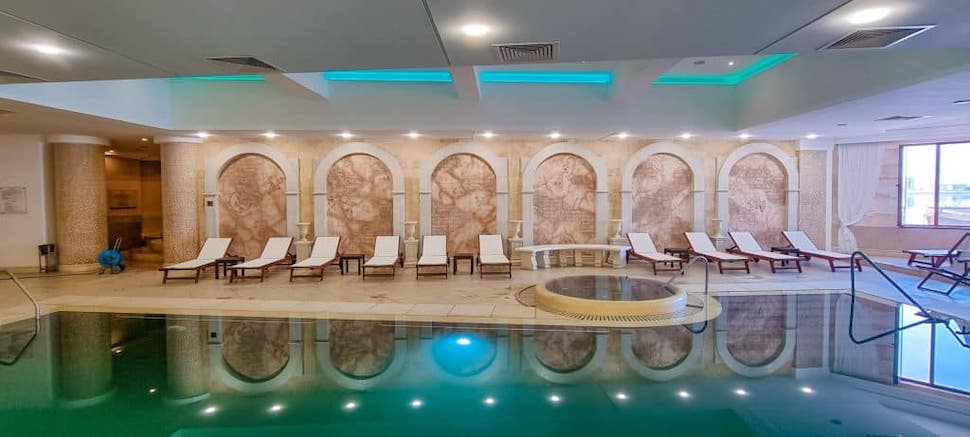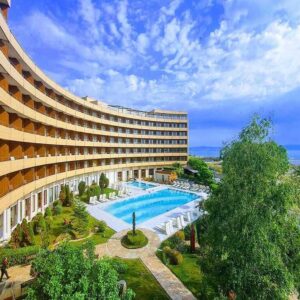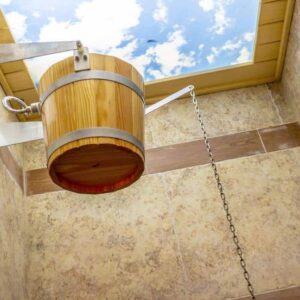
As Andrea Bocelli belts out Time to Say Goodbye in Italian, I am greeted by a masseur who was, I am guessing, a weightlifter for the Bulgarian Olympic team in a previous life. As he hovers, I strip down and get on the table and the massage begins. He starts by standing at the head of the table near the face cradle, working his strong hands down my back. It feels amazing, although the bliss is a bit offset by the feel of his copious belly bouncing off my head. Even though he is big, and I am tiny, he is working hard throughout the rubdown. I can tell. When I turn over, I notice him wiping away large beads of sweat from his forehead with the small washcloth placed strategically around his neck.
 As you might glean from the first paragraph of this story, what I am about to describe to you is not the typical spa experience. And I will preface the rest of the story—if I haven’t telegraphed the point already—that what I am about to describe is not an experience for everyone. But, lest you think you are able to read a pan, think again.
As you might glean from the first paragraph of this story, what I am about to describe to you is not the typical spa experience. And I will preface the rest of the story—if I haven’t telegraphed the point already—that what I am about to describe is not an experience for everyone. But, lest you think you are able to read a pan, think again.
Even though my experience at the Grand Hotel Pomorie in Bulgaria was unusual, to say the least, after five days of massages, mud baths, mineral wraps, and more, I felt like a new person. What’s more, the cost for the six-night stay, including a room at the four-star resort, two meals a day, a meeting with a doctor, five one-hour massages, 16 other treatments lasting between 20 to 30 minutes each, and full access to a suite of wellness facilities cost—drum roll, please—$1,000 US.
Defining the European Medical Spa Experience
I have been spending a lot of time at European medical spas lately, believing them to be the continent’s best-kept wellness tourism concept. For centuries, Europeans have flocked to spa towns like Baden-Baden in Germany, Bath in England, and Karlovy Vary in the Czech Republic to tend to their health by taking the waters and imbibing in other nature-based treatments prescribed by medical doctors. Today, the tradition continues throughout the continent among Europeans, with a smattering of international guests mixed in. But most Americans are unaware that they too can take the waters, and imbibe in other wellness treatments as well, at a fraction of the cost of an American spa resort.
After five days of massages, mud baths, mineral wraps, and more, I felt like a new person.
For some reason, my experiences with European medical spas have taken place solely in countries that were formerly under the yoke of communism. But medical spas exist throughout Europe, from the Baltics to the Balkans and everywhere in between. That said, the biggest bargains to be found are in off-the-radar places like Slovakia, Romania, and Bulgaria, perhaps because the medical spas in these countries cater mainly to a local clientele. As a result, in the places I have visited to date, the food and the service has been a bit below what the typical American traveler might expect. Additionally, the English-speaking ability of the staff has been spotty. But, as I will emphasize again and again in this article, the quality of the medical care and the value for the money more than make up for the lack of language skills, gourmet cuisine, and obsequious service.
With those caveats in mind, let me provide you with a play-by-play of my experience at the Grand Hotel Pomorie, located on Bulgaria’s southeastern Black Sea coast.
The Price is Right
 Upon checking in, I went immediately to the spa, where I was met by the well-coiffed spa director. While her accent was heavy, she was fluent in English, which was useful given that she served as the translator during my meeting with the head doctor. The 70-something doctor seemed to understand what I was saying without the translator’s help, perhaps reading into my body language. After a 40-minute conversation, he prescribed a five-day regimen, which would include a daily mud bath, a daily Black Sea lye wrap, a daily ultrasound session, a daily electro-stimulation session, and a daily 60-minute massage. He also told me to take three daily 30-minute dips in the wellness center’s salt water pool.
Upon checking in, I went immediately to the spa, where I was met by the well-coiffed spa director. While her accent was heavy, she was fluent in English, which was useful given that she served as the translator during my meeting with the head doctor. The 70-something doctor seemed to understand what I was saying without the translator’s help, perhaps reading into my body language. After a 40-minute conversation, he prescribed a five-day regimen, which would include a daily mud bath, a daily Black Sea lye wrap, a daily ultrasound session, a daily electro-stimulation session, and a daily 60-minute massage. He also told me to take three daily 30-minute dips in the wellness center’s salt water pool.
While in the modern wellness area, I could also use a range of amenities, including a Kneipp path, a contrast rain shower, a cold plunge, a salt room, a steam room, and several saunas (including one of the infrared variety).
My daily schedule was handwritten on a card which I presented to the spa technicians each time I went for a treatment. Treatments were largely clumped together in the morning, with the exception of the massage, which I chose to experience toward the end of the day. That way, I could spend most of the afternoon sight-seeing, relaxing, or hanging out in the wellness center.
Breakfast and dinner were buffet-style. The soundtrack was 1980s Euro-pop (think ABBA), and the food was a little stale, as well. However, with an abundance of choices, there was always something palatable to be found. That said, when I tired of the hotel’s food, I could hop walk to downtown Pomorie, which had a range of restaurants featuring local seafood and other fresh regional cuisine. The room was extremely comfortable, complete with a balcony overlooking the Black Sea, a comfy king-size bed, and in-room amenities like a mini-fridge and a safe.
Because the Grand Hotel Pomorie mainly caters to Bulgarians, room prices are low. In the off-season, a room with half-board can cost as little as $88 a night. That means five nights come in well under $500. Adding to the value equation, if you stay for at least five days of care, you receive a 30 percent discount off already-low treatment prices. That’s why the grand total for the spa portion of my bill came in under $500. So, taking the value for the money factor into account, the price for this experience, despite all of the caveats, was beyond right. After all,the goal of this experience was to leave feeling better than when I came, and in that regard, the Grand Hotel Pomorie more than delivered a winning vacation.
Laura Powell
Laura Powell has covered the worlds of travel and wellness for more than 25 years for the likes of CNN, The Washington Post, and Skift. Find out more at www.tourismwelldefined.com or on Instagram @tourismwelldefined